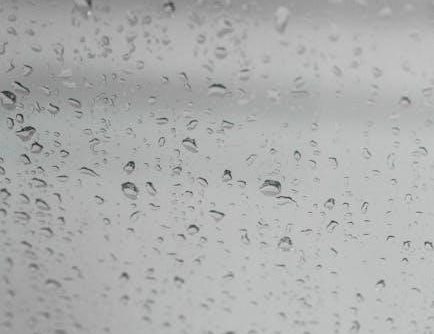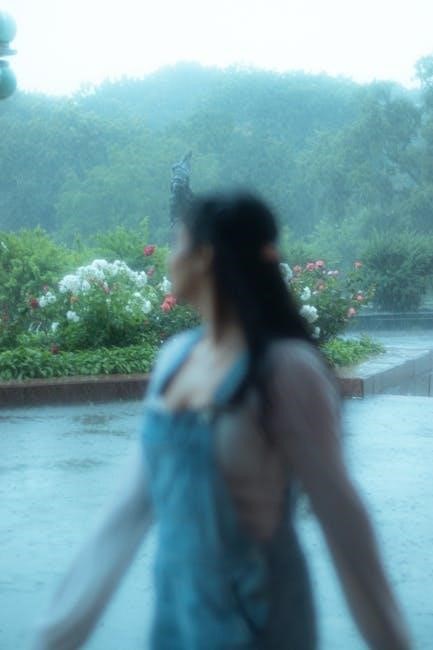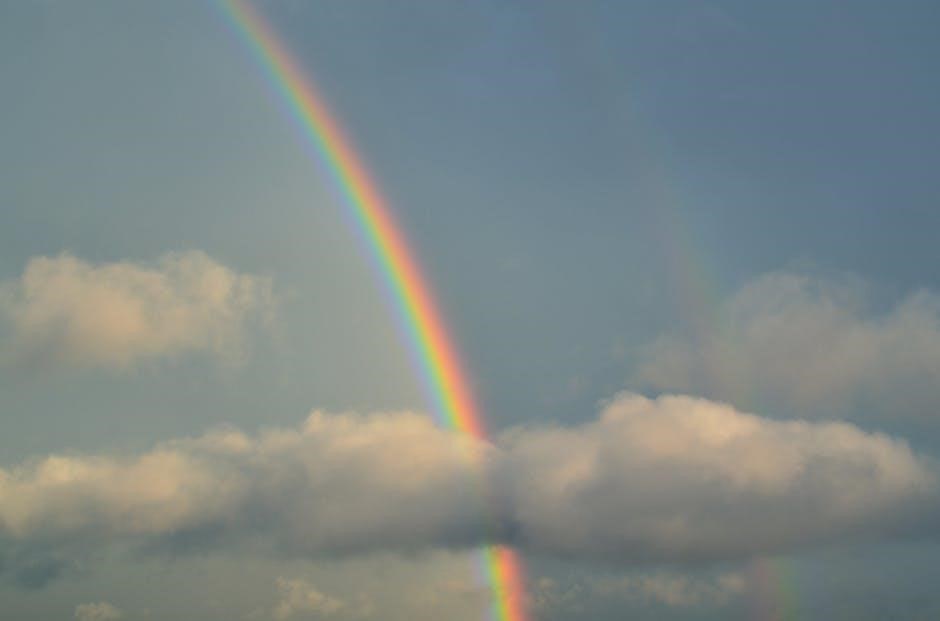
Ray Bradbury’s There Will Come Soft Rains is a haunting tale of a post-apocalyptic world, exploring themes of technology, nature, and humanity’s absence, set in a lone surviving house.
1.1 Background of the Story
There Will Come Soft Rains, written by Ray Bradbury in 1950, is set in a post-apocalyptic world where a lone house survives a nuclear disaster. The story explores the contrast between advanced technology and the absence of human life, with the house’s automated systems continuing their routines despite the desolation. Its title, inspired by Sara Teasdale’s poem, reflects nature’s indifference to humanity’s fate. The story is widely available in PDF format for educational and literary analysis.
1.2 Ray Bradbury’s Vision of a Post-Apocalyptic World
Ray Bradbury’s vision in There Will Come Soft Rains depicts a chilling post-apocalyptic world where humanity has vanished, likely due to nuclear war. The story, set in August 2026, centers on a lone, automated house that continues its routines despite the absence of its owners. Bradbury’s narrative highlights the contrast between the persistence of technology and the inevitable return of nature, offering a poignant reflection on human existence and the transience of civilization.

Plot Structure and Chronological Events
The story unfolds chronologically, detailing the automated house’s morning routine, the arrival of a diseased dog, and the voice-clock’s relentless announcements. Breakfast is prepared, children’s voices call out, but no one responds. Lunch follows, and a tree branch sparks a fire, destroying the house by evening, symbolizing nature’s reclaiming of a world without humanity.
2.1 The Morning Routine of the Empty House
The story begins at seven o’clock with the voice-clock announcing the time and routine tasks. The house, devoid of human life, mechanically prepares breakfast and performs chores. Despite the emptiness, the clock persistently reminds of schedules, creating an eerie contrast between automation and absence. The morning unfolds with precision, highlighting the futility of routine in a post-apocalyptic world where no one remains to acknowledge it.
2.2 The Arrival of the Dog and the Intrusion of Mud
A dog, once large and fleshy but now gaunt and covered with sores, arrives at the front porch. The front door recognizes the dog’s voice and opens, allowing it to enter. The dog tracks mud through the house, angering the mice who are forced to clean up. This intrusion highlights the clash between nature’s chaos and the house’s technological order, disrupting the otherwise pristine environment.
2.3 The Role of the Voice-Clock in the Narrative
The voice-clock serves as a persistent narrative device, marking time and attempting to maintain order in an empty, post-apocalyptic house. It announces schedules like “seven o’clock” and “eight-one o’clock,” emphasizing the absence of human life. Its relentless ticking and announcements contrast sharply with the silence, highlighting the futility of technological routine without human presence. This creates a haunting atmosphere, underscoring the story’s themes of isolation and the failure of technology to sustain life.
Major Themes in the Story
The story explores themes of technology vs. nature, the inevitability of destruction, and the absence of human life, highlighting the clash between progress and existence.

3.1 The Contrast Between Technology and Nature
The story vividly contrasts technology and nature, depicting a house with automated routines struggling to survive amidst a devastated natural world. The voice-clock and mechanical systems embody technological persistence, while the encroaching mud, swallows, and frogs symbolize nature’s resilience. This contrast underscores Bradbury’s warning about the limitations of technology in the face of nature’s enduring cycles, highlighting humanity’s absent role in this delicate balance.
3.2 The Inevitability of Destruction and Renewal
The story illustrates the inevitability of destruction through the house’s systematic collapse and the renewal of nature. Despite the house’s technological resilience, its eventual burning signifies the unstoppable forces of decay. Meanwhile, nature, represented by swallows and frogs, thrives in the ruins, suggesting that life persists even after catastrophic events. This duality emphasizes the cyclical nature of existence, where destruction and renewal are intertwined as natural processes beyond human control.
3.3 The Absence of Human Life and Its Implications
The absence of human life in the story underscores the devastating consequences of nuclear war. The empty house, once filled with family routines, now echoes with silence, highlighting humanity’s eradication. The voice-clock’s relentless announcements and the house’s automated functions mock the absence of humans, emphasizing the futility of technological advancements without life to sustain them. This void serves as a stark reminder of the irreversible loss of human existence and civilization’s fleeting nature.

Symbolism in the Story
The house symbolizes civilization and human achievement, while its emptiness reflects the transience of human existence. Nature’s resilience, like swallows and frogs, contrasts with technological collapse, emphasizing life’s enduring cycle.
4;1 The House as a Symbol of Civilization
The house in There Will Come Soft Rains symbolizes the pinnacle of human civilization and technological advancement. It is fully automated, maintaining routines like breakfast preparation and school reminders, even in the absence of human life. Its meticulous order and advanced features contrast with the post-apocalyptic chaos outside, highlighting humanity’s achievements and their eventual futility. The house’s destruction by fire underscores the impermanence of human creations and the inevitable decline of civilization.
4.2 The Significance of the Voice-Clock
The voice-clock in There Will Come Soft Rains symbolizes the relentless march of technology and time, even in a world devoid of human life. It rigidly adheres to its programmed schedule, announcing times for waking, eating, and leaving, despite the emptiness of the house. Its incessant voice underscores the futility of human routines and the detachment of technology from human presence, serving as a poignant reminder of civilization’s abandonment and the inevitability of decay.
4.3 The Fire as a Catalyst for Transformation
The fire in There Will Come Soft Rains serves as a transformative force, symbolizing both destruction and renewal. It engulfs the house, breaking the monotony of its automated routines and accelerating its collapse. The flames, spreading through the attic, underscore the inevitability of decline and the failure of technology to sustain life. Ironically, the fire clears the way for nature’s reclamation, aligning with Bradbury’s theme of life persisting even after human and technological extinction, creating a cyclical narrative of destruction and rebirth.

The Role of Nature in the Story
Nature intrudes into the empty, technological house, symbolizing resilience and renewal. Rain, mud, and wildlife challenge the sterile, automated environment, highlighting life’s persistence without humanity.
5.1 The Renewal of Life After Disaster
Nature demonstrates resilience as life renews after catastrophe. Swallows, frogs, and wild plum trees symbolize enduring cycles, contrasting with the destroyed house. Rain cleanses the ground, and wildlife thrives, showing nature’s persistent vitality despite humanity’s absence. The story underscores the Earth’s ability to heal and regenerate, even as human creations crumble; This renewal highlights nature’s indomitable will to survive and flourish amidst devastation.
5.2 The Swallows, Frogs, and Wild Plum Trees as Symbols of Nature’s Resilience
The swallows, frogs, and wild plum trees symbolize nature’s resilience and cyclical renewal. Despite the apocalypse, these elements thrive, embodying life’s persistence. The swallows’ shimmering sounds and frogs’ night songs illustrate nature’s undeterred beauty. Wild plum trees, trembling yet vibrant, represent growth amidst ruin. Bradbury uses these images to highlight nature’s adaptability and enduring spirit, contrasting with humanity’s catastrophic end. They signify hope and continuity in a shattered world.

The Story’s Ending and Its Implications
The house catches fire at night, symbolizing the end of human-dominated civilization. The destruction underscores the inevitability of technological collapse without human oversight, leaving only ruins behind.
6.1 The Climactic Fire and Its Aftermath
The house catches fire at night, likely from a stray spark or malfunction. Flames spread rapidly, engulfing the attic and causing an explosion. The once-resilient structure collapses, leaving only ruins. This event symbolizes the end of human civilization’s last remnant, emphasizing the inevitability of destruction without human intervention. The fire’s aftermath marks a return to nature’s dominance, as the house, once a symbol of technology, is reduced to rubble.
6.2 The House’s Ultimate Fate and the Cycle of Destruction
The house, once a symbol of human ingenuity, meets its end in a catastrophic fire. Its destruction marks the final collapse of civilization, leaving only ruins. This event underscores the cyclical nature of destruction and renewal, as nature begins to reclaim the land. Bradbury uses the house’s demise to highlight humanity’s impermanence and the inevitability of return to a natural order, emphasizing the futility of technological endeavors without human presence to sustain them.
Educational Significance of the Story

Bradbury’s story is widely used in high school and college curricula for its rich themes, encouraging critical thinking about technology, nature, and humanity’s role in the world.
7.1 Use in High School and College Curricula
The story is frequently included in high school and college syllabi for its exploration of themes like technology, nature, and humanity. Its concise yet profound narrative makes it ideal for teaching literary analysis, encouraging students to reflect on societal and environmental issues. The availability of the story in PDF format facilitates easy access for students, enabling annotations and close reading exercises that deepen understanding of Bradbury’s vision and its relevance to contemporary discussions.
7.2 Discussion Questions and Analysis Points
- How does the empty house symbolize humanity’s absence and the futility of technological advancement?
- What role does the voice-clock play in emphasizing the passage of time and the lack of human interaction?
- Discuss the contrast between the house’s automated routines and the surrounding natural world.
- Analyze the significance of the poem’s title and its relevance to the story’s themes of destruction and renewal.

Availability of the Story in PDF Format
The story is available as a PDF on Google Drive and Google Sheets, offering insights into themes, analysis, and educational discussions.
8.1 Sources for Downloading the PDF
- The PDF version of There Will Come Soft Rains is available on Google Drive and Google Sheets.
- It can also be accessed through educational platforms like Google Docs and Scribd.
- Additionally, the story is featured on music and literature websites such as musicabaltica.com.
8.2 Features of the PDF Version
The PDF version of There Will Come Soft Rains includes the full text of the story, annotations, and discussion questions for educational use. It features high-resolution formatting, making it easy to read and analyze. The document also includes background information on Ray Bradbury and the historical context of the story, enhancing its educational value. Additionally, the PDF highlights key themes and symbols, aiding in deeper comprehension of the narrative.

The Story’s Legacy and Adaptations
There Will Come Soft Rains has been adapted into choral music by Ēriks Ešenvalds, showcasing its enduring cultural impact and timeless themes in various artistic forms.
9.1 Cultural Impact and Recognition
Ray Bradbury’s There Will Come Soft Rains has left an enduring mark on literature and culture, resonating with themes of technology and nature. Widely used in educational curricula, it sparks discussions on humanity’s role in a post-apocalyptic world. Its haunting imagery and poetic prose have inspired adaptations, including Ēriks Ešenvalds’ choral piece, further cementing its place in cultural consciousness and artistic interpretation across generations and mediums.
9.2 Adaptations in Media and Art
There Will Come Soft Rains has inspired various adaptations, including a choral piece by Ēriks Ešenvalds, blending music with Bradbury’s poignant imagery. Animators and artists often use the story as source material, drawn to its vivid scenes of a lone house and a shattered world. These adaptations highlight the story’s universal appeal, transcending literature to influence visual and auditory art, ensuring its legacy endures across creative mediums and generations.